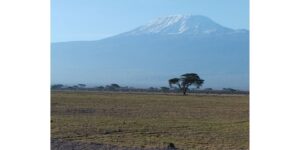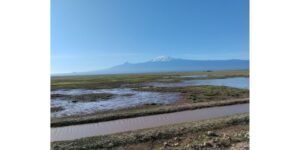Flying into Amboseli, Kilimanjaro is hidden in the clouds and refuses to show itself the entire day. My heart sinks hopping that the world’s tallest stand-alone mountain will show itself, and it does the following days pasted against the bluest of skies with its snow-capped peak – Kibo. We photograph it from Amboseli’s many facets – the swamps, the lake, the doum and acacia forests including the iconic Amboseli salt pan that is actually an ancient lake bed that only fills during the rains as it did during the deluge in 2018 that flooded the park. Part of the salt pan is water-filled but as the drought bites, the water is drying up.
It’s a different Amboseli from a year ago where the lake was brimming crimson with thousands of Lesser flamingos that had descended to it gorge on the algae that thrives in salty waters when conditions are perfect. Now there are only a few Greater flamingos clad in white and pelicans but the other wading birds colour the waters. The Goliath heron – the world’s largest – stands statuesque in the shallow water waiting for a fish to grasp, the ducks and geese, the dainty lily trotters and jewel-bedecked Malachite kingfishers grace the lake.

Amidst the feathered flocks, the hippos and elephants revel in the grass-filled swamps to feast on the grasses on either side of the narrow road. But the drought is taking its toll and animals carcases litter the ground.
The swamp suddenly gives way to the dry salt pans and photographing Kilimanjaro from here, you’d think we’re in a desert. Then, camouflaged by the side of the road, a handsome black-manned lion and his female are in slumber oblivious to us. Like what all lions do best, they spend most of the day resting in order to keep their body temperature stable. The reason being, lions lack sweat glands but make up for that by panting heavy.

We’re sure there are more lions around in the bushes near this mating pair – and a search reveals we’re not wrong. Through the binoculars, it’s a large pride that the mating pair has distanced itself from.
Even though the swamps are water-laden and busy, the large herds of elephants that were there in 2021 have left the park in search of forage. Dr Cynthia Moss, the grand matriarch of the elephants who started elephant research in Amboseli National Park in 1972 – making Amboseli’s elephants one of the longest researched elephants in the wild – states, “Most of the elephants are outside the Park, trying to find vegetation. In fact, there are only about 200 in the Park.”
It’s a revelation. Amboseli National Park boasts 700 elephants in the park at any one time and 1,700 in the larger ecosystem.
“A year like this one shows how absolutely essential the greater Amboseli ecosystem is to the elephants and other wildlife,” continues Dr Moss.
The elephant researcher gives more insight to the current situation. “In 2020 there was a huge baby boom but now the birth rate is low. This is not because of the drought but because of the 22-month gestation period. So the elephants who might give birth in 2022, will have conceived in 2020 and early 2021.”

Sadly, many elephants have died due to the current drought – mostly calves.
But the drought isn’t the only crisis that the elephants and other animals face. Outside the national park, huge plantations of maize and avocados continue to crop up on the migratory corridors painting a concerning picture for Africa’s wildlife.
About Amboseli
The 392-square-kilometre park, Amboseli is part of the larger 3,500-square-kilometre Amboseli.
Stay at Ol Tukai Lodge, named after the palm tree with great views of Kilimanjaro. On a two-night stay, there’s time relax by the pool, enjoy a massage and exciting game drives.
Drive via Emali or via Namanga on Tanzanian border to Amboseli average 215 kms.
Or fly 45 minutes with Safarilink or Airkenya and book a safari cruiser for game drives via the lodge you are at.
The Amboseli Trust for Elephants was founded by the eminent scientist, Dr Cynthia Moss in 1972. 600 elephant individuals have been monitored since 1976 by ATE.
You can find out more about Amboseli’s lions from Lion Guardians that monitor some 400 lions and working with communities to save the King of the Beast.
Credit: Source link